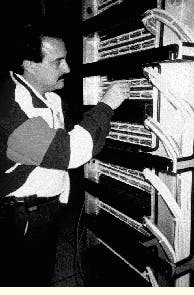Training installers--one companys experience
When Cablesys looked at technical training in Connecticut, it found that the only way to ensure properly trained technicians was to develop its own program.
F. Byrne Stoddard, Jr.
For three years, Cablesys, a North Haven, CT, telecommunications cabling installation company, has been plagued by this question: "Where do we find enough technically trained and qualified cable installers to keep up with the growing demand for our services?" Cablesys` answer was, "We`ll teach them ourselves at our own version of Cable Tech."
Terry Buono, president at this 7-year-old company, found himself in a quandary when workforce needs had to be met. "We simply couldn`t find qualified technicians during a period when our business was doubling," Buono explains. "We were looking for specialists trained in Category 5 backbone wiring and state-of-the-art telephone equipment. Private technical schools weren`t turning out students with the skills we needed, and state vocational schools offered a 2-year program covering low-voltage wiring systems that included a lot of material our technicians would never use."
The first step Cablesys took toward solving its workforce problem was to investigate the training resources available in its home state (see "The state of technical training in Connecticut," page 37). Everything the company discovered in this investigation pointed to the need for an internal training program tailored to telecommunications cabling technicians.
In-house solution
Buono and Vice President Steve Vincent worked together for two years as a telecommunications cabling installation team when, in 1988, they started their own full-time cabling business, Cable Systems of North Haven Inc., also known as Cablesys. By 1990, demand for their technical services had grown, so they added two more installers. By the end of last year, the company`s workforce swelled to 20 full-time field installation and service personnel, and annual sales approached $1 million.
Sales for 1995 are expected to exceed $1 million, and 1996 sales are projected to increase by at least 30%, requiring the addition of at least 10 employees. At this point, a limiting factor in the company`s expansion is its ability to recruit, train and deploy qualified technical field personnel.
Another limiting factor in its growth is the high standards Cablesys has set for company performance. These standards are intended to deliver a high level of service and responsiveness to customers--even when requests require short-notice work during the evening, overnight or on weekends. Employee training, therefore, must cover business as well as technical issues.
One more factor that impacts Cablesys` training needs is an ongoing shift in the composition of its work. "Our current business mix is roughly 50% telecommunications and 50% backbone systems," explains Buono. "That`s a shift from an 80/20 ratio three years ago, when data transmission began to be a key factor in our industry. We see the mix continuing to shift during the next three years; then data transmission will account for about 70% of our volume, with pure telecommunications at 30%." This shift requires an increase in skilled personnel in data communications, without necessarily calling for a decrease in telephone-system installers.
Informal internal training
Given the unpromising manpower situation in the state and the complicated training-related factors affecting Cablesys business, Buono and Vincent eventually gave up on trying to find either public or private educational sources to supply the skilled technicians the company needed. Two years ago, they began to develop their own internal training program.
"At first," Buono recalls, "the training was informal and unstructured. When we got four or five people who needed to know more about Category 5 installation than they could learn on the job, we`d invite them in on Wednesday night for a private tutoring session on the subject. The classes typically took about two hours. If questions and answers got lively, we might even stay three."
Later, Buono found his technicians needed training on more sophisticated, advanced telephone systems, including UMT-8/16/32/64 systems. That training, in turn, led to a need for advanced tutoring on telephone-system programming.
"Just about the time we`d get four or five people trained, we`d find ourselves with six new employees who needed the same training all over again," Buono adds.
He found that no state or regional trade group conducted training classes in the way that union contractors and their locals run technical training. Also, the lack of a cohesive state telecommunications cabling trade organization--for example, the Building Industry Consulting Service International Inc. at the Connecticut level--meant that no private-sector source was providing any input to the state licensing and vocational-education agencies on establishing licensing and apprentice training programs.
To address these concerns and fulfill Cablesys` training needs, according to Buono, "we decided to formalize our training program--to establish a fixed curriculum based on the most up-to-date information available in the industry, to put it all down on paper and to get the material organized to a point where we could teach it on a scheduled basis one evening per week."
Several months of research followed--searching through bookshelves, looking in file drawers and sifting personal materials. Finally, Buono produced a solid collection of curriculum materials to begin the telecommunications portion of the course, including manuals, books and publications. Next, many telephone calls, letters and personal visits to Category 5 cable and equipment manufacturers produced another pile of literature sufficient to let him design the data-communications section of the curriculum.
The formal training program was launched in the spring of 1994. A class of eight met on Wednesdays at the company offices. That year, the fall class numbered 10, with two new employees joining the group. In late winter of 1995, the course material was expanded and refined, new material was added and more emphasis on programming large telephone systems was included. This fleshed-out curriculum was conducted over a 10-week period.
Classroom setting
"We now have 21 personnel in the current class," reports Buono, "including most of those who went through the earlier version of the course."
The course is now run in a true classroom setting. North Haven High School, a Cablesys telecommunications customer, has made available a lecture hall with first-rate teaching facilities, including blackboards, whiteboards and projection screens.
Attendance is mandatory for all unlicensed employees and optional for licensed personnel who wish to advance their technical knowledge. Students attend without pay--and the instructors, Buono and Vincent, teach without additional pay. The long-range plan for "Cable Tech" is to hire a qualified vocational-education teacher to take over most of the evening instruction.
Buono estimates the new version of the course will cost the company approximately $3250 per 10-week semester, including his and Vincent`s time, and books and materials for 20 students. "That`s a bargain--except for the time Steve and I have to take away from other aspects of running the company," he says.
Taking a lesson from the unionized building trades, Cablesys has come to recognize the value and importance of an ongoing training program, including apprentice training and journeyman skill upgrading. "We are considering doing what the union contractors have done for decades," Buono says, "and that is to put 10, 15 or 20 cents an hour per person into a separate training fund, and include it in our billing rates as part of the cost of doing business."
The State of Technical Training in Connecticut
While the stampede to get on the Information Superhighway gains momentum, 100-megahertz data transmission is a subject that is not even included in current Connecticut T-2 telecommunications journeyman licensing requirements. The reason is obvious: Category 5 cable and other telecommunications technology is brand new, but the state`s telecommunications licensing requirements are not. They were adopted when the Bell system was dismantled in the early 1980s, followed a few years later by the local regional Bell operating company, Southern New England Telephone Co., spinning off several subsidiaries. Modification of existing regulations takes months or years, because licensing requirements are subject to a long series of reviews and approvals by several state agencies.
In addition, much of the knowledge and many of the skills needed to obtain an electrician`s license have been around for decades, leading to training programs that have not significantly changed for years. For example, current training in telecommunications offered in the International Brotherhood of Electrical Workers joint apprentice training programs in Connecticut is limited to fiber-optic cabling systems--which represents only 5% of the telecommunications backbone market today. No specific Category 5 training is offered, and few, if any, unionized electrical contractors are gravitating toward this market in the state.
At the same time, private technical schools in Connecticut have not been turning out qualified technicians, even at the apprentice level. The best that Cablesys has found among these graduates have been electronic and computer technicians who understand electronic and telecommunications theory, but have virtually no practical experience in wiring and cabling systems. Few have expressed any interest in a career as installers; they want to work on the equipment for which they have been trained--computers, peripherals and telecommunications devices.
Only one state-operated technical high school offers coursework that is needed to perform telecommunications work. However, this school does so within a broader curriculum that encompasses all low-voltage wiring, including installation of fire and burglar alarm systems and other low-voltage apparatus.
According to Cablesys, the problem with this curriculum is that it begins with fundamental electrical principles, with students spending 144 hours in class--the minimum state-recommended time--learning about Ohm`s Law and other basic electrical theory. Students eventually get to modern voice- and data-transmission technology. But even then, current developments in telecommunications technology are not adequately covered. Also, it takes two years to cover the curriculum, after which the student can sit for the license examination.
Cablesys, however, requires its new employees to have more than just classroom knowledge. Whenever possible, it hires technicians with on-the-job experience, including some background in telephone-system installation. When the company hires technicians, those employees are assigned to job sites where they must be immediately productive.
All these factors led Cablesys to the conclusion that the only way to meet its expanding workforce requirements was to design and conduct its own course in telecommunications installation technology.
Steve Vincent, vice president at Cablesys, covers telecommunications system installation procedures for "Cable Tech" students. He oversees all company field installations and operations.
Key sections of the curriculum materials have been gathered into a 50-page journeyman`s study guide that is issued to all personnel.
Classes also serve as a weekly personnel meeting for such activities as distribution of new beeper/pagers for all field personnel and instruction on their use.
Cablesys President Terry Buono checks quality of workmanship at major Category 5 cabling installation at the Bell Atlantic Mobile facility in Wallingford, CT.
F. Byrne Stoddard, Jr. is a journalist, communications specialist and freelance business writer based in New Haven, CT. His work, which covers a variety of industrial, technical, commercial and labor relations issues, has appeared in dozens of business magazines throughout the country.




